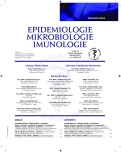A point prevalence survey of healthcare-associated infections in the Slovak Republic – a part of the EU project
Authors:
S. Litvová 1; I. Rovný 2; H. Hudečková 3; V. Meluš 4; M. Štefkovičová 1,4
Authors place of work:
Regionálny úrad verejného zdravotníctva so sídlom v Trenčíne, Trenčín
1; Úrad verejného zdravotníctva Slovenskej republiky, Bratislava
2; Ústav verejného zdravotníctva Jesseniova lekárska fakulta UK, Martin
3; Trenčianska univerzita A. Dubčeka v Trenčíne, Trenčín
4
Published in the journal:
Epidemiol. Mikrobiol. Imunol. 63, 2014, č. 2, s. 107-112
Category:
Souhrnná sdělení, původní práce, kazuistiky
Summary
Aim:
The aim of this survey was to estimate the prevalence of healthcare-associated infections (HAI) in the Slovak Republic (SR), distribution of causative pathogens, and risk factors.
Methods:
The point prevalence survey (PPS) of HAI in the SR was carried out in 40 acute care hospitals, according to a standardized methodology developed by the European Centre for Disease Prevention and Control (ECDC). Data were collected according to the standard protocol at the country, hospital, and patient levels.
Results:
Of 8 397 patients included in the survey in the SR, 298 (3.5%) had HAI. The highest prevalence of HAI (12.4%) was found in the intensive care units (ICU) and Anaesthesiology and Intensive Care Medicine Units (AICMU). Nevertheless, intensive care medicine patients only represented 6.5% of all patients.
The following six most common types of HAI accounted for 87.3% of all HAI:
urinary tract infection (26.2%), pneumonia and other lower respiratory tract infections (22.0%), surgical site infection (15.7%), bloodstream infection (9.9%), infection of the eye, ear, and upper respiratory tract (8.3%), and skin and soft tissue infection (5.2%). The most often isolated pathogens were Escherichia coli (15.0%), Klebsiella spp. (12.5%), and Pseudomonas aeruginosa (10.8%). Of 8 397 surveyed patients, 60.5% had a medical device inserted: central vascular catheter (CVC)(3.4%), peripheral vascular catheter (PVC)(40.8%), urinary catheter (14.1%), or endotracheal tube (2.1%). The prevalence of HAI was higher in patients with than without a medical device inserted.
Conclusion:
By participating in the PPS, the SR has collected the most recent data on HAI and antimicrobial use in acute care hospitals. The adherence to the standard methods, standard definitions of HAI, and PPS protocol allows to repeat the survey, to analyse the HAI prevalence trend, and to take effective interventions.
Keywords:
healthcare-associated infections – point prevalence survey
Zdroje
1. Palmore TN. Enhancing Patient Safety by Reducing Healthcare-Associated Infections: The Role of Discovery and Dissemination. Infect Control Hosp Epidemiol, 2010, 31:118–123.
2. European Centre for Disease Prevention and Control. Point Prevalence survey. Stockholm: ECDC; 2010 [online]. [cit.2013-07-15]. Dostupné na www: http://www.ecdc.europa.eu/en/activities/surveillance/HAI/about_HAI-Net/Pages/PPS.aspx.
3. European Centre for Disease Prevention and Control. Annual epidemiological report 2012, Stockholm: ECDC; 2013, s. 245. ISBN 978-92-9193-443-0.
4. European Centre for Disease Prevention and Control. Annual epidemiological report on communicable diseases in Europe 2008.Stockholm: ECDC; 2008. [online]. [cit. 2013-03-08]. Dostupné na www: http://ecdc.europa.eu/en/publications/Publications/0812_SUR_Annual_Epidemiological_Report_2008.pdf.
5. Zarb P, Coignard B, Griskeviciene J, Muller A et al. The European Centre for Disease Prevention and Control (ECDC) pilot point prevalence survey of healthcare-associated infections and antimicrobial use. Euro Surveill, 2012;17(46):pii=20316. [online]. [cit.2013-04-27]. Dostupné na www: http://www.eurosurveillance.org/ViewArticle.aspx?ArticleId=20316.
6. Litvová S, Štefkovičová M, Kološová A, Murajda L. Výsledky pilotnej bodovej prevalenčnej štúdie nozokomiálnych nákaz v SR. Donovaly 2011, XIV. Ročník odbornej konferencie Surveillance nemocničných nákaz v zdravotníckych zariadeniach, CD zborník.
7. European Centre for Disease Prevention and Control. Point prevalence survey of healthcare-associated infections and antimicrobial use in European acute care hospitals – protocol version 4.3.Stockholm: ECDC, 2012.s.73. ISBN 978-92-9193-366-2.
8. Žabková E, Murajda L, Hudečková H. Point prevalence survey of nosocomial infections in University Hospital in Martin. Acta Medica Martiniana, 2011; 11/1, s. 35–40. ISSN: 1335-8421.
9. Suetens, C. ECDC Point Prevalence Survey of HAI and Antimicrobial use in acute care hospitals 2011-2012, preliminary results. Joint Annual Meeting of the Antimicrobial Resistance and Healthcare-associated Infections (ARHAI) Networks. 26–28 November 2012, Berlin.
10. European Centre for Disease Prevention and Control. Point Prevalence Survey of healthcare-associated infections and antimicrobial use in European acute care hospitals, 2011-2012. Report. Stockholm: ECDC; 2013, p 207. [online ]. [cit. 2013-07-21]. Dostupné na www: http://www.ecdc.europa.eu/en/publications/Publications/healthcare-associated-infections-antimicrobial-use-PPS.pdf
11. Výročná správa o činnosti Regionálnych úradov verejného zdravotníctva v Slovenskej republike 2012. [online]. [cit.2013-05-27]. Dostupné na www: http://www.uvzsr.sk/docs/vs/vyrocna_sprava_SR_12.pdf
12. Máderová E, Červenka J. Niektoré výsledky zo štúdie prevalencie nozokomiálnych nákaz v SSR, Lek Obz, 1989;38(2):83–91.
13. Šrámová H, Máderová E. The prevalence of nosocomial infection in Czechoslovakia. Cesk Epidemiol Mikrobiol Imunol, Praha: Československá lékarská společnosť. 1989;38(3):140–149.
Štítky
Hygiena a epidemiológia Infekčné lekárstvo MikrobiológiaČlánok vyšiel v časopise
Epidemiologie, mikrobiologie, imunologie

2014 Číslo 2
- Parazitičtí červi v terapii Crohnovy choroby a dalších zánětlivých autoimunitních onemocnění
- Očkování proti virové hemoragické horečce Ebola experimentální vakcínou rVSVDG-ZEBOV-GP
- Koronavirus hýbe světem: Víte jak se chránit a jak postupovat v případě podezření?
Najčítanejšie v tomto čísle
- Bodové prevalenčné sledovanie nozokomiálnych nákaz na Slovensku – súčasť projektu Európskej únie
- Výskyt Candida dubliniensis v klinickém materiálu a možnosti její identifikace
- Q-horečka jako profesionální onemocnění vedoucí k invaliditě – kazuistika
- Diagnostika Clostridium difficile infekcí – porovnávací studie dvou imunoenzymatických metod s konfirmací pomocí PCR a kultivace s následnou ribotypizací kmene*
